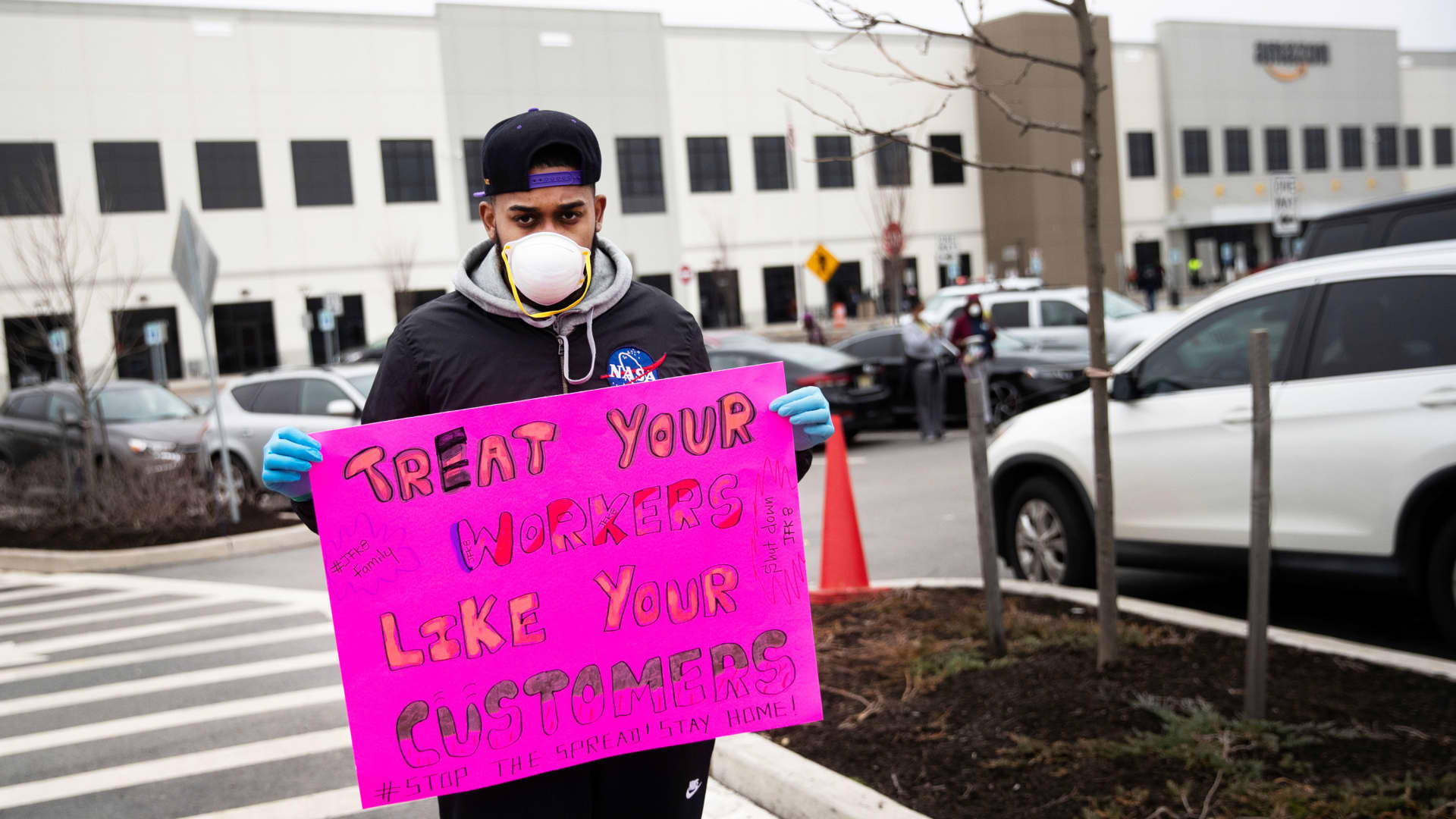How fears of electromagnetic radiation spawned a snake-oil industry
Illustration by Alex Castro / The VergeThe products target people who think they have electromagnetic hypersensitivity Continue reading…

If you buy something from a Verge link, Vox Media may earn a commission. See our ethics statement.
The pager-sized stainless steel Springlife polarizer looks like not much more than a small metal box. The “sound healing energy” website that sells it claims that it’s made up of “special minerals and Earth substances” that attract and soak up “specific wavelengths of cosmic radiation.” It’s advertised as a way to block electromagnetic fields, though with no clear or proven explanation of how or why. It costs over $200, but you can buy a bigger one for over $350.
But David Fancy, who believes he’s sensitive to electromagnetic fields, says it’s the only thing — other than moving into a tent on a friend’s woodlot in Ontario, Canada — that helped the blinding headaches, full-body nerve pain, and brain fog he says he’d been experiencing since 2001. And he’s tried a lot of different products: he says he spent about $2,500 on cell phone stickers, handheld so-called energy shields, and other devices advertised as ways to make him feel better.
“My experience has been that 90 percent of these devices don’t work,” he says.
But the chance they might have was enough for him to spend the money. Fancy, a professor at Brock University’s dramatic arts department in Ontario, has very real symptoms that he attributes to a controversial condition called electromagnetic hypersensitivity (EHS). EHS ascribes symptoms ranging from dizziness to headaches or pain to the waves coming off of devices like cell phones or microwaves. In the US, it’s considered a fringe health theory, and the reasons for its symptoms are hotly debated among doctors and scientists. Numerous peer-reviewed studies found no scientific link between exposure to electromagnetic fields (EMFs) and illness, though many studies say further research needs to be done to understand people’s symptoms.
Because of his condition, Fancy is an easy target for companies selling products that claim to protect against low-frequency radiation. Others who believe they have EHS are targeted as well. And, being largely isolated by and skeptical of the mainstream medical community, they’re particularly susceptible to the marketing, says Fancy. “They are desperate, and they are very prone to spending the remaining money that they have on some kind of shortcut device that’s allegedly going to help them.”
This has only escalated over the past few years, experts say. Both the pandemic and the growing prominence of health misinformation and conspiracies online have created the perfect environment for snake-oil salesmen to thrive, tapping into distrust in and legitimate concerns about the healthcare industry and offering expensive, useless devices as a solution.
“There’s such an appeal to find something that will cure you of something … because mainstream and modern medicine have not,” says Kolina Koltai, a postdoctoral fellow at the University of Washington who researches misinformation. “You felt like you’ve either been ignored or dismissed. So [profiteers] are coming in to fill that void.”
Origins of snake oil
“Snake oil” products claiming to protect humans from radio waves became common as fears of radiofrequency radiation grew throughout the 20th century. The rise of radios, microwaves, and cell phones each triggered a new wave of fears about radiofrequency radiation.
“Radiation has characteristics that increase people’s sense of risk – you can’t see it,” says Kenneth Foster, a professor emeritus at the University of Pennsylvania who has been studying radiation’s impact on humans since 1976. People often confuse non-ionizing radiation — the low-frequency radiation that comes from our cell phones or home appliances that cannot damage DNA or cells directly — with ionizing radiation like X-rays that can be potentially harmful to humans, he says.
As early as the 1970s and ‘80s, experimental studies on radiation were a big business, says Charles Stevens, a neuroscientist who chaired a National Academy of Sciences committee on radiation risk. There was plenty of government and private funding available for research on electromagnetic radiation, and the studies conducted with that funding were not always accurate, he says. Others were then able to use those flawed studies to back products that claimed to offer protection.
The issue was further complicated by a 2013 report from the International Agency for Research on Cancer (IARC), which reviewed the evidence and classified radiofrequency energy, like the type emitted from cell phones, as a “possible carcinogen.” But those studies, like many that came before it, had too many weaknesses to determine a definite link to cancer, writes Timothy Jorgensen in his book Strange Glow: The Story of Radiation. Calling cell phone scares “an epidemic without a disease,” he writes, “If cell phones are truly killing us with brain cancer, we have to ask, where are the bodies?”
By the early 2000s, as cell phones and Wi-Fi became common in most homes and public controversies about their safety emerged, profiteers jumped at the opportunity to create “protective” cell phone patches and stickers. The Federal Trade Commission issued a consumer warning about the products in 2011.
That hasn’t dissuaded groups from pushing out similar products, which became more numerous throughout the 2000s and 2010s as cell phones became ubiquitous. Consumers can spend thousands ($487–$5,600) on devices that claim to “shield” the body from EMFs: radiation-blocking underwear ($45); silver-infused hats ($45); pendants ($99); and cell phone stickers ($69) — the latter of which is one of the most common accessories on the market. Crystals made from orgonite, a substance based on pseudoscientific theories from the 1940s, are popular on sites like Etsy and Amazon for their claims to “balance out” energy like EMFs.
At no other time in history have those products — and the people who claim they work — been so accessible and easy to sell, says Peter Knight, a professor of American Studies at the University of Manchester. As influencers spread misinformation about radiation online, “They’re able to put links to Amazon and other sites that allow them to very easily monetize the idea that they’re selling,” he says.
Does this thing really work?
The product push accelerated during the COVID-19 pandemic, with strong links to anti-vaccine groups. Disinformation “super spreaders” — who account for 65 percent of anti-vaccine content online, according to the Center for Countering Digital Hate — have seen rapid audience growth. Anti-vaccine influencers like Joseph Mercola and Robert F. Kennedy Jr. have pushed narratives about 5G and the danger of EMFs alongside vaccine misinformation, and their books and products are supported by platforms like Amazon.
“During the pandemic, one of their biggest selling points … was basically to say, ‘We’re being silenced, we’re being censored, and this cure is being hidden from you by big pharma,’” says Azadeh Azi Ghafari, a California psychotherapist.
Smaller companies, too, seem to have grown since the beginning of the pandemic. In 2020, the German company Waveguard — which sells “Qi shield” devices that claim to protect the user from “all EMF fields, including 2G, 3G, 4G, and 5G” — had $1.7 million in total assets, up from $1.1 million the year before. The Qi shield is sold as small portable boxes ($550), or tubes ($1,195), or as a stationary “home cell” that can be placed in the center of a room or home ($3,579–$6,479).
But, like other products, the Qi shield’s claims don’t hold up under scrutiny. Waveguard’s sole US partner, Synergy Science, promises that scientific studies by the German tech inspection company TÜV SÜD (that the company notably sponsored) prove their effectiveness. But rather than showing that the device “significantly reduces exposure when near EMF signals,” as its website claimed, the study showed that the device merely deflects the radiation field so that measurements are different when the device is present. That doesn’t mean it provides any “protection” from the low-frequency radiation energy present, Thomas Oberst, a spokesperson for TÜV SÜD, wrote in a statement to The Verge. In fact, it may actually increase the exposure. Synergy Science removed the study from its website after being contacted by The Verge but did not provide comment.
Hagen Thiers, who founded Waveguard in 2014, said in an interview with The Verge that he doesn’t dispute the conclusions from the TÜV SÜD report but maintains that the product does help people with EHS. He says the TÜV study was only a waypoint to other studies, like one from the German lab Fraunhofer. Sponsored by Waveguard, the study did find that some participants who slept with the device closer to their bodies reported better sleep quality. But the study also found “no clear effects of a one-week exposure with the Qi-shield on subjective well-being, stress, and sleep quality.”
“We emphasize the need to replicate the results within a new study and sample,” the report concluded.
Foster, the radiation expert, dismissed the results of the study as showing a “total lack of effectiveness” of the product and any other product claiming to protect people from EMFs. At best, the danger most of these products present is to vulnerable consumers’ wallets. But at worst, they can be potentially harmful to one’s health.
Several companies that sell EMF protective products have received warnings from the US Food and Drug Administration, including a company called Basic Reset, whose dietary supplements and medical devices were recalled in 2019 after claiming to address a number of ailments from allergies to pain. Basic Reset’s products had “the potential to be unsafe or ineffective for their particular uses, and could lead to adverse health impacts,” the FDA said in its recall notice. (The company was ordered to shut down operations in 2019.) In December, the Netherlands’ Authority for Nuclear Safety and Radiation issued a warning on 10 anti-5G products that were found to emit harmful ionizing radiation and had the potential to cause long-term health damage.
And misinformation researcher Koltai says it’s also dangerous when bad actors can profit off of their theories, like ones linking electromagnetic radiation to health problems. If the products based on those theories are lucrative, they have financial incentives to keep circulating bad information. That could lead to further harm those who are already vulnerable and distrustful of mainstream medicine — people like Fancy and the thousands of others who say they suffer from EHS who are targeted by companies selling the products.
Marketing materials for companies like the Vivobase ($279–$750), for example, say that they’re “especially for electrosensitive people.” DefenderShield, a company that sells products that range from protective phone cases ($75) to blankets ($40–$500) and wallpaper ($200), was founded by a man who published a book in 2017 about the “proven health risks” of EMFs and how they “specifically affect children and those suffering with electromagnetic hypersensitivity.” August Brice, founder of the blog Tech Wellness, says she suffers from EHS. Brice often “debunks” other shielding devices as unhelpful to hypersensitive people and encourages them to purchase her own line of products instead. And a simple Google search for “how to treat electromagnetic hypersensitivity” pulls up a blog post with links to EMF-blocking products as a top result.
Even though these products are pushed on people who believe they’re suffering from EHS, and who have very real physical symptoms, they aren’t helping them. They’re just taking advantage of people who feel like they have few other places to turn.
And, if the marketing hype works well enough, these patients are left spending more and more money to try more and more devices — which can keep them from getting the medical care they need, says Ghafari. “Where it’s dangerous is telling people that that is a treatment that’s going to help you.”

 BigThink
BigThink 
































